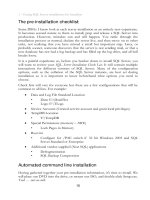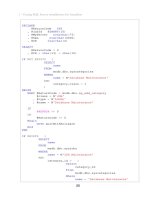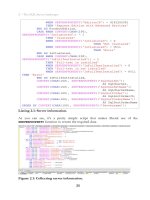SQL Server Tacklebox- P30 pps
Bạn đang xem bản rút gọn của tài liệu. Xem và tải ngay bản đầy đủ của tài liệu tại đây (177.19 KB, 5 trang )
145
CHAPTER 6: MONITORING AND
NOTIFICATIONS
As is probably clear by this stage, there are many potential monsters, lurking
around corners, waiting to pounce upon the unwary DBA as he goes about his
day-to-day duties. Often, however, the biggest problem is not the monster itself
but the fact that the DBA is unaware that it exists.
Imagine a problem as trivial as a SQL Agent Service that fails to start; a very easy
problem to fix once you know about it. But what if you don't know about it and
then suddenly find out that the backup process that this service was supposed to
be running has not been executed for over two weeks! The feeling at this moment
for a DBA, or DBA manager, is one of frustration and disbelief. These emotions
are quickly displaced however, perhaps after a few minutes alone with the warm
blankie and a soft floor, by an unswerving confidence. This confidence derives
from that fact that you know that positive steps will be taken to ensure that this
never happens again.
In this chapter, I will describe how I use monitoring tools and techniques to make
sure that my Blackberry will always buzz whenever a backup fails, a disk drive fills
up, or a rogue process is threatening the performance of a SQL Server.
When the inevitable happens, and the e-mail notification hits your mobile device,
probably at some awful hour of the morning, I'll show what you can do to easily
ascertain the problem and be notified, using a mix of third party tools, such as Red
Gate's SQL Response, and standard tools like Database Mail.
Types of monitoring and notifications
The DBA's life is one of vigilantly overseeing not only the SQL Servers
themselves, but all of the events that take place on the servers. When I say
events, I am not specifically referring to error events that cause entries to be added
to the Windows Event log or SQL Server Error log, though these are certainly
included in an overall monitoring and notification strategy. Here, I am referring to
events such as SQL Server Agent job failure, or an abnormal SQL Server
performance condition, or excessive resource (e.g. disk space) utilization, or SQL
Services availability.
It is not possible for a DBA team, no matter how large, to keep this vigil by
themselves. They need automated notifications that will let them know when
6 – Monitoring and notifications
146
something goes awry, so that they can respond to the event and resolve any issues
arising from it. There are many ways that DBAs can set up such notifications,
either using native SQL Server tools, such as Database Mail or SQL Agent Mail
(two separate entities), or a third party monitoring and notification system. There
are quite a number of such applications on the market.
In my career, I have generally employed a hybrid solution of both native and
third-party monitoring, because of the benefits and limitations of each. For
example, a third-party application may not be able to retrieve the internal error
messages of a failed SQL Agent database backup job. Conversely, it would be
impractical to set up performance monitoring, say for a sustained level of high
CPU utilization, for each instance of a 200-strong SQL Server farm, when a
centralized third party solution could easily be maintained.
In this chapter, I will expound upon the types of events that would require such a
monitoring and notification system to be in place and then give examples of
solutions for each.
SQL Agent Job failures
We all know that failures occur and that the reasons for the failures are many-fold.
SQL Agent Jobs, which kick off SSIS packages or maintenance tasks, such as
database backups or integrity checks, are common points of failure. It is your job
as DBA to respond to the failure, overcome it, and finally to understand why the
failure occurred in the first place and make sure it does not happen again.
In this chapter, I will cover only one such type of failure, but it is one close to the
DBA's heart and that is database backup failure. Regardless of whether you run
your database and transaction log backup jobs via a third party tool or natively,
perhaps using a Database Maintenance Plan, they are scheduled processes and if
there is a failure you must be made aware of it. I happen to use Red Gate's SQL
Backup utility (not a plug, just reality), which has built-in notifications for backup
failures. However, being a duly cautious DBA, I do not rely on this notification
mechanism being fail proof. I will show how to setup notifications for
failed backup jobs at several different points, so that if one notification fails,
others will not.
Adverse performance conditions
SQL Server is adept at managing memory, I/O requests and multi-threading
across multiple CPUs. Occasionally, however, a "rogue" query will push the SQL
Server to its very limits and it becomes unresponsive, as if its feelings have been
hurt by the indignity of it all.
6 – Monitoring and notifications
147
By the time we enter the unresponsive phase, it may be too late to glean what
nefarious query it was that caused the problem in the first place. What is needed,
in order to ensure a DBA's restful sleep, is an application that can monitor the
server, using a time-based algorithm, and fire a notification when a specific
threshold is crossed. For example, we may request a notification if CPU utilization
exceed 85% for a set number of minutes.
There are many such third-party applications that will handle this very well, Idera
Diagnostic Manager, Argent Guardian and Microsoft Operations Manager
(MOM) are a few that come to mind. I will show how to use one such application,
Red Gate's SQL Response, to trigger these performance alerts.
Further, once notified of the performance issue at hand, I will demonstrate how to
use two indispensable tools, Performance Monitor and SQL Profiler, to quickly
and easily analyze and resolve the problem.
Service availability
It should go without saying that a SQL service, such as SQL Server service (the
database engine) or SQL Server Agent service, stopping is an event to which the
sleepy DBA should be notified (I make it sound like these alerts always happen at
night; they don't. It's just the ones that do tend to stay with you).
So, how does SQL Server notify you that it is down? It doesn't. It is down, and so
cannot send a notification. This, again, would be the work of a third party
monitoring application. Such monitoring solutions should also have the ability to
take corrective action when encountering a stopped service, such as trying to
restart the service.
I'll show how to use a third party tool, such as SQL Response, to monitor these
services, and also how to configure the SQL services to have some resilience when
they stop unexpectedly.
Disk space shortage
Chapter 4 discussed how to manage data growth, and the space issues that can be
caused by bulk loads, errant indexing, abuse of TempDB, and so on. I can state
unequivocally that disk space alerts are the most common type of alert that the
DBA will face.
Disk space is not cheap, despite what you might be told by some IT managers.
SCSI and fiber channel drives, which are the core storage devices for most
SANs, are still quite expensive on a "per Meg" basis, compared to the slower
SATA or ATA drives that are commonly used in development, staging or QA
SQL Server installations.
6 – Monitoring and notifications
148
For production servers that require many hundreds of Gigs of storage, it is
essential that you analyze growth trends to make sure you will not be caught naked
in the front yard when the application crashes because there is no more space
(naked in the front yard? Forget that analogy). The bottom (ugg) line is that you
need to be alerted not when you are completely out of disk space but when you
have a specified percentage of remaining space, so that there is still time to act. In
this chapter I will cover how to be alerted to uncontrolled data growth.
Enabling notifications
Enabling notifications in SQL Server is a straightforward process that simply
entails setting up a mechanism by which to send the notification emails, and then
defining who it is who should receive them.
Setting up database mail
Database mail is an essential first component in enabling the delivery of
notifications in SQL Server, and its set up is included in the Automated
Configuration Script in Chapter 1.
While there are other options for being notified of events, such as by Pager or Net
Send, they are not really viable in today's world of mobile devices. Thankfully,
SQL Server 2005 and beyond offers an SMTP mail client for both SQL Server
(database engine) and the SQL Agent (job scheduler).
If you have to set up mail for SQL 2000, which a lot of people still do due to the
cost of upgrading and/or lack vendor support (yes, this still happens, even in 2009
as I write this very sentence) then my heart goes out to you. Having to install
and test a MAPI client like Outlook just to send mail from SQL 2000 is
beyond frustrating.
NOTE
A website still exists to assist you in your SQL Server 2000 mail woes and that
is It offers
an SMTP mail client for
SQL Server 2000. It does not, sadly, address the SQL Agent mail, but it is
worth a look.
Setting up Database Mail in SQL Server 2005 or 2008 is very straightforward. You
just need to configure:
• The default profile that will be used to send mail
• An SMTP server address
• An account from which the mail will be sent
6 – Monitoring and notifications
149
Figure 6.1 shows the profile information from the Database Mail Configuration
Wizard, launched by double-clicking Database Mail under the Management tab
in SQL Server Management Studio.
Figure 6.1: Profile for Database Mail in SQL Server 2005.
Notice that the Profile name is "Notifications" and it is associated with the
Account called "Standard SQL Mail Account". It is this profile and account
association that allows Database Mail to send true SMTP mail, using a standard
email stored procedure,
sp_send_dbmail.
The account information, which stores the SMTP server address, is set up
separately from the profile. The account properties, which are directly associated
with a profile, can be seen in Figure 6.2.









